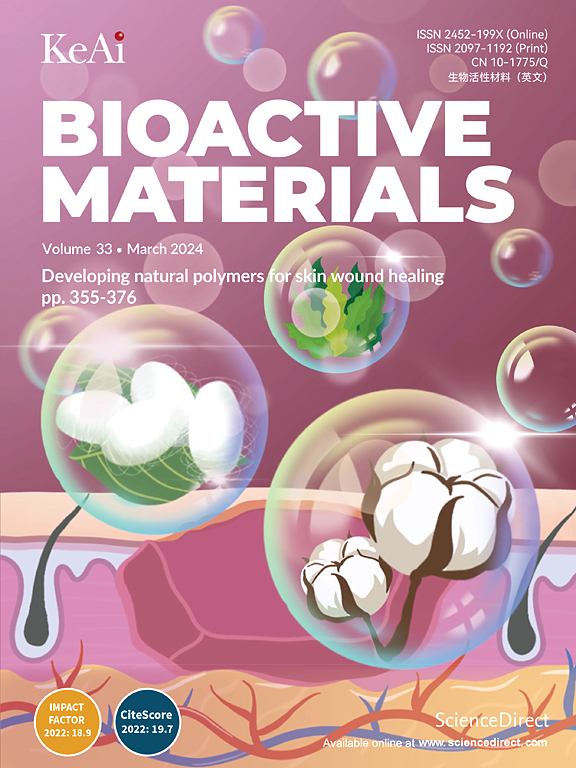Mytilus edulis foot protein mimics for tailoring long-acting endothelium-mimicking anti-thrombotic surfaces
IF 18
1区 医学
Q1 ENGINEERING, BIOMEDICAL
引用次数: 0
Abstract
Surfaces with enduring and superior antithrombotic properties are essential for long-term blood-contacting devices. While current surface engineering strategies integrating anticoagulants and antiplatelet agents show promise in mimicking the non-thrombogenic properties of the endothelium, their long-term effectiveness remains limited. Here, we report an easy-to-perform, dual-biomimetic surface engineering strategy for tailoring long-acting endothelium-mimicking anti-thrombotic surfaces. We first designed a Mytilus edulis foot protein-5 (Mefp-5) mimic rich in amine and clickable alkynyl groups to polymerize-deposit a chemical robust coating onto the surface through a mussel-inspired adhesion mechanism. Then, a clickable nitric oxide (NO, an antiplatelet agent)-generating enzyme and the anticoagulant heparin were sequentially co-grafted onto the chemical robust coatings via click chemistry and carbodiimide chemistry. Our results demonstrate that this engineered surface achieved an impressive NO catalytic release efficiency of up to 88 %, while heparin retained 86 % of its bioactivity even after one month of exposure to PBS containing NO donor. Both in vitro and in vivo experiments confirmed that this robust endothelium-mimicking coating substantially reduces thrombosis formation. Overall, our long-acting endothelium-mimicking anti-thrombotic coatings present a promising and feasible strategy to address thrombosis-related challenges associated with blood-contacting devices.

Mytilus edulis足蛋白模拟物用于定制长效内皮模拟抗血栓表面
对于长期与血液接触的设备来说,具有持久和卓越抗血栓性能的表面至关重要。虽然目前整合了抗凝剂和抗血小板剂的表面工程策略在模拟内皮的非血栓形成特性方面显示出了前景,但其长期有效性仍然有限。在此,我们报告了一种易于操作的双仿生表面工程策略,用于定制长效内皮模拟抗血栓表面。首先,我们设计了一种富含胺和可点击炔基的贻贝足蛋白-5(Mefp-5)模拟物,通过贻贝启发的粘附机制,在表面聚合沉积一层化学稳健涂层。然后,通过点击化学和碳化二亚胺化学,将可点击的一氧化氮(NO,一种抗血小板药物)生成酶和抗凝剂肝素依次接枝到化学坚固涂层上。我们的研究结果表明,这种工程化表面的氮氧化物催化释放效率高达 88%,而肝素在暴露于含有氮氧化物供体的 PBS 中一个月后仍能保持 86% 的生物活性。体外和体内实验都证实,这种强大的仿内皮涂层能大大减少血栓的形成。总之,我们的长效内皮模拟抗血栓涂层为解决与血液接触设备有关的血栓相关难题提供了一种前景广阔的可行策略。
本文章由计算机程序翻译,如有差异,请以英文原文为准。
求助全文
约1分钟内获得全文
求助全文
来源期刊

Bioactive Materials
Biochemistry, Genetics and Molecular Biology-Biotechnology
CiteScore
28.00
自引率
6.30%
发文量
436
审稿时长
20 days
期刊介绍:
Bioactive Materials is a peer-reviewed research publication that focuses on advancements in bioactive materials. The journal accepts research papers, reviews, and rapid communications in the field of next-generation biomaterials that interact with cells, tissues, and organs in various living organisms.
The primary goal of Bioactive Materials is to promote the science and engineering of biomaterials that exhibit adaptiveness to the biological environment. These materials are specifically designed to stimulate or direct appropriate cell and tissue responses or regulate interactions with microorganisms.
The journal covers a wide range of bioactive materials, including those that are engineered or designed in terms of their physical form (e.g. particulate, fiber), topology (e.g. porosity, surface roughness), or dimensions (ranging from macro to nano-scales). Contributions are sought from the following categories of bioactive materials:
Bioactive metals and alloys
Bioactive inorganics: ceramics, glasses, and carbon-based materials
Bioactive polymers and gels
Bioactive materials derived from natural sources
Bioactive composites
These materials find applications in human and veterinary medicine, such as implants, tissue engineering scaffolds, cell/drug/gene carriers, as well as imaging and sensing devices.
 求助内容:
求助内容: 应助结果提醒方式:
应助结果提醒方式:


